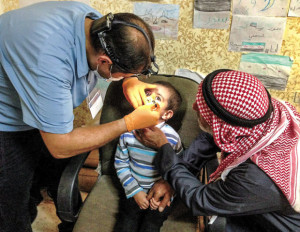Cold comfort for refugees this Christmas
Thousands of refugees across Europe and the Middle East are bracing for a cold winter far from home.
As the official figure for the number of asylum seekers who have entered Germany reaches one million, thousands more are continuing their journeys and will be on the road in the coming months, despite falling temperatures and dangerous migration routes.

Refugees in Europe and the Middle East are at risk of infection
Health experts say the medical challenges posed by this at-risk population are complicated by a harsh environment, increasing the risk of outbreaks of chronic disease.
The threat of infection is equally daunting, says Dr Christopher Tedeschi, a disaster and humanitarian medicine expert from Columbia University.
“Once migrants reach a destination, vaccination is a crucial first line defense. Children from countries with disrupted health systems risk having missed regular childhood vaccines, notably for rotavirus and pneumonia,” Dr Tedeschi said.
“For all refugees, measles and polio vaccines are critical,” he said.
“Vaccinations are offered to newcomers at some registration points and border crossings, but preventing outbreaks also depends on proper sanitation, clean water, and safe housing, all of which have been challenges with an increasingly mobile population.
“Louse-borne relapsing fever has already been reported in a group of Somali refugees living in Italy,” he said.
Even more concerning is the prospect of cholera.
“In October, Syrian physicians that a five year-old boy had likely died of cholera in Aleppo,” Dr Tedeschi said.
“But since cholera thrives in warm water, the risk may decrease as temperatures drop. By then, influenza season will be in full swing. In close quarters among a highly mobile population, a significant influenza outbreak could represent a serious public health emergency. Administration of influenza vaccine in the coming months might prove to be the most important intervention of all.
“Finally, the refugee population faces acute gaps in services related to care for chronic illnesses such as hypertension and diabetes, as well as in services specific to vulnerable populations like children – and especially unaccompanied minors – and those in need of mental health care.”
Within European borders, NGOs like MSF (Medecins Sans Frontieres) remain essential, but their efforts need to be complemented by coordinated medical systems organized by host nations and WHO and UNHCR, Dr Tedeschi said.
“Ultimately, the greatest difficulty in caring for such an ill-defined population may be determining where they are in the first place, and matching human resources to needs. That doesn’t necessarily mean physicians – providers such as nurse practitioners, mental health providers, midwives and community health workers are a critical resource.
But in many places, the migrant population is poorly characterized and difficult to track.
According to one report, 80 percent of Syrian refugees in Jordan are ‘self-settled,’ outside of traditional camps. They compete on the open market for health care, and authorities may be at a loss when it comes to quantifying overall numbers and tracking patients from place to place.
Even when populations are well accounted for, integrating them into existing health care systems takes time.
Estimates suggest that another 500,000 asylum seekers will enter Germany in coming months.
Currently, individuals are offered vaccinations, TB screening and health assessments upon first being registered in the German system.
For up to 15 months thereafter, asylum seekers are offered limited access to the health care system, qualifying only for emergent or acute care and obstetric services.
During this time, new European residents may rely on aid organizations for the provision of ongoing care.
This can only be accomplished with coordination between NGOs, funding agencies, the UN, and host governments. Months or years from now, falling short on this score may mean an increased burden of complications of chronic disease, preventable infection, and mental health morbidity.
Dr Tedeschi says that while the European health care system is robust enough to handle most types of outbreak or emergency, the sheer number of new arrivals, along with delays in initiating routine ongoing care, will create both expected and unanticipated challenges.
“The health ministries of the European Community, in partnership with NGOs, need a coordinated and well-funded plan to mitigate the already enormous health impact as well as the potential consequences of this mass migration,” he said.
Laurie Nowell
AMES Australia Senior Journalist












